Theoretical Evaluation of Photovoltaic Thermal Water Source Heat Pump, Application Potential and Policy Implications: Evidence from Yangtze River Economic Belt, China
Abstract
1. Introduction
2. Modeling
2.1. Description of System and Control Strategy
2.2. Therml and Electrical Efficiency Analysis
2.3. Energy Balance Analysis
2.4. Economic Analysis
2.4.1. Annual Investment Cost
2.4.2. Additional Investment Payback Period (PBP)
2.5. Environmental Analysis
3. Model
3.1. TRNSYS Model
3.2. Model Verification
4. Case Study
4.1. Energy Analysis Results
4.2. Economic Analysis Results
4.3. Environmental Analysis Results
5. Conclusions
- A new photovoltaic thermal-water source heat pump system, PV/T-GSHP, is proposed for the first time.
- A new hybrid system (GHE) photovoltaic river water source heat pump system, the TRNSYS model of PV/T-GSHP, is developed. The model considers three modes of regulation for heating season and building needs to improve energy efficiency and economy.
- The annual power output of PV/T-GSHP system, from the west to the east of the Yangtze River, shows a phase growth trend, which is related to the light intensity. In addition, the annual heat output of PV/T plate gradually decreases from the lower reaches of the Yangtze River to the upper reaches.
- During the heating period, due to the relatively high average water temperature in Wuhan, its heating COP reached 3.42, while the heating COP in Shanghai, Nanjing and Anqing, which are located in the lower reaches of the Yangtze River, gradually decreased, because Shanghai can meet the optimal solar radiation conditions of the PVT auxiliary mode. According to the change of water temperature, the cooling COP gradually increases from the downstream to the upstream.
6. Policy Implications
- The results show that compared with the traditional system (single WSHP system), it has a high application potential in integrating higher energy returns, lower operating costs and high pollutant emissions. It is suggested to construct and popularize the composite system in areas with rich water resources and solar radiation.
- The benefits of comprehensive utilization of solar energy and surface water and heat energy in the lower reaches of the Yangtze River are the largest, and the amount of carbon reduction is also the largest. In the middle and upper reaches of the Yangtze River, the utilization of surface water should be emphasized.
- The optimal size, operation and policy support of PV/T-WSHP system under different conditions will be the subject of future research to make the configuration more feasible and commercial.
Funding
Informed Consent Statement
Data Availability Statement
Conflicts of Interest
Nomenclature
| c | Specific thermal capacity, |
| d | Discount rate |
| h | Heat transfer coefficient, W m−2 K−1 |
| Mass flow, kg/s | |
| A | Area, m2 |
| G | Solar radiation, W/m2 |
| P | Power, W |
| Q | Energy, J |
| R | Thermal resistance, m2 K/W |
| S | Net absorbed solar radiation per unit area, W/m2 |
| T | Temperature, K |
| W | Power output, W |
| Z | Cost, Yuan |
| Greek symbols | |
| transmittance-absorptance | |
| η | Efficiency |
| Ψ | Temperature coefficient of PV cell |
| κ | Solar irradiance coefficient |
| ρ | Density of the fluid |
References
- Zhang, Z.; Zhou, Y.; Zhao, N.; Li, H.; Tohniyaz, B.; Mperejekumana, P.; Hong, Q.; Wu, R.; Li, G.; Sultan, M. Clean heating during winter season in Northern China: A review. Renew. Sustain. Energy Rev. 2021, 149, 111339. [Google Scholar] [CrossRef]
- International Energy Agency (IEA). Tracking Industrial Energy Efficiency and CO2 Emissions; IEA: Paris, France, 2007. [Google Scholar]
- Zhang, Y.; Wang, S.; Shao, W.; Hao, J. Feasible Distributed Energy Supply Options for Household Energy Use in China from a Carbon Neutral Perspective. Int. J. Environ. Res. Public Health 2021, 18, 12992. [Google Scholar] [CrossRef]
- Duan, X.; Jiang, Y.; Wang, B.; Zhao, X.; Shen, G.; Cao, S.; Huang, N.; Qian, Y.; Chen, Y.; Wang, L. Household fuel use for cooking and heating in China: Results from the first Chinese Environmental Exposure-Related Human Activity Patterns Survey (CEERHAPS). Appl. Energy 2014, 136, 692–703. [Google Scholar] [CrossRef]
- Wang, J.; Zhou, Z.; Zhao, J.; Zheng, J.; Guan, Z. Towards a cleaner domestic heating sector in China: Current situations, implementation strategies, and supporting measures. Appl. Therm. Eng. 2019, 152, 515–531. [Google Scholar] [CrossRef]
- Zhao, Z.; Wang, R.; Ge, L.; Wu, J.; Yin, Q.; Wang, C. Energy utilization of coal-coking wastes via coal slurry preparation: The characteristics of slurrying, combustion, and pollutant emission. Energy 2019, 168, 609–618. [Google Scholar] [CrossRef]
- Oliveira, M.L.S.; Pinto, D.; Tutikian, B.F.; da Boit, K.; Saikia, B.K.; Silva, L.F.O. Pollution from uncontrolled coal fires: Continuous gaseous emissions and nanoparticles from coal mines. J. Clean. Prod. 2019, 215, 1140–1148. [Google Scholar] [CrossRef]
- Cong, H.; Zhao, L.; Meng, H.; Yao, Z.; Huo, L.; Jia, J.; Wu, Y. Applicability evaluation of biomass pyrolytic poly-generation technology on clean heating in northern rural of China. J. Agric. Eng. 2018, 34, 8–14. [Google Scholar]
- Yang, W.; Zhou, J.; Xu, W.; Zhang, G.Q. Current status of ground-source heat pumps in China. Energy Policy 2010, 38, 323–332. [Google Scholar] [CrossRef]
- Jiang, Z.; Lyu, P.; Ye, L.; Zhou, Y.W. Green innovation transformation, economic sustainability and energy consumption during China’s new normal stage. J. Clean. Prod. 2020, 273, 123044. [Google Scholar] [CrossRef]
- Su, D.; Zhou, W.; Du, Q.; Huang, Y. Technical Characteristics in the Diffusion of Cleaner Residential Heating System in China: The Case of Air-Source Heat Pump Technology. Trop. Conserv. Sci. 2019, 12, 1940082919855912. [Google Scholar] [CrossRef]
- Jin, L.; Duan, K.; Tang, X. What Is the Relationship between Technological Innovation and Energy Consumption? Empirical Analysis Based on Provincial Panel Data from China. Sustainability 2018, 10, 145. [Google Scholar] [CrossRef]
- Li, K.; Jiang, Z. The impacts of removing energy subsidies on economy-wide rebound effects in China: An input-output analysis. Energy Policy 2016, 98, 62–72. [Google Scholar] [CrossRef]
- Wang, Y.; Zhou, S.; Huo, H. Cost and CO2 reductions of solar photovoltaic power generation in China: Perspectives for 2020. Renew. Sustain. Energy Rev. 2014, 39, 370–380. [Google Scholar] [CrossRef]
- Ma, S.; Guo, S.; Zheng, D.; Chang, S.; Zhang, X. Roadmap towards clean and low carbon heating to 2035: A provincial analysis in northern China. Energy 2021, 225, 120164. [Google Scholar] [CrossRef]
- He, J.; Li, Z.; Zhang, X.; Wang, H.; Dong, W.; Chang, S.; Ou, X.; Guo, S.; Tian, Z.; Gu, A.; et al. Comprehensive report on China’s Long-Term Low-Carbon Development Strategies and Pathways. Chin. J. Popul. Resour. Environ. 2020, 18, 263. [Google Scholar] [CrossRef]
- Dehghan, A.A.; Movahedi, A.; Mazidi, M. Experimental investigation of energy and exergy performance of square and circular solar ponds. Sol. Energy 2013, 97, 273–284. [Google Scholar] [CrossRef]
- Rath, B.B.; Marder, J.M. Powering the future—Does the fuel gage read empty? Adv. Mater. Process. 2007, 165, 28–29. [Google Scholar]
- Qi, L.; Zhang, Y. Effects of solar photovoltaic technology on the environment in China. Environ. Sci. Pollut. Res. 2017, 24, 22133–22142. [Google Scholar] [CrossRef]
- Noro, M.; Lazzarin, R. PVT and ETC Coupling for Annual Heating and Cooling by Absorption Heat Pumps. Sustainability 2020, 12, 7042. [Google Scholar] [CrossRef]
- Kircher, K.J.; Zhang, K.M. Heat purchase agreements could lower barriers to heat pump adoption. Appl. Energy 2021, 286, 116489. [Google Scholar] [CrossRef]
- Averfalk, H.; Ingvarsson, P.; Persson, U.; Gong, M.; Werner, S. Large heat pumps in Swedish district heating systems. Renew. Sustain. Energy Rev. 2017, 79, 1275–1284. [Google Scholar] [CrossRef]
- Barton, J.; Huang, S.; Infield, D.; Leach, M.; Ogunkunle, D.; Torriti, J.; Thomson, M. The evolution of electricity demand and the role for demand side participation, in buildings and transport. Energy Policy 2013, 52, 85–102. [Google Scholar] [CrossRef]
- Connolly, D. Heat Roadmap Europe: Quantitative comparison between the electricity, heating, and cooling sectors for different European countries. Energy 2017, 139, 580–593. [Google Scholar] [CrossRef]
- Jacobson, M.Z.; Delucchi, M.A.; Bauer, Z.A.F.; Goodman, S.C.; Chapman, W.E.; Cameron, M.A.; Bozonnat, C.; Chobadi, L.; Clonts, H.A.; Enevoldsen, P.; et al. 100% Clean and Renewable Wind, Water, and Sunlight All-Sector Energy Roadmaps for 139 Countries of the World. Joule 2017, 1, 108–121. [Google Scholar] [CrossRef]
- Ruhnau, O.; Bannik, S.; Otten, S.; Praktiknjo, A.; Robinius, M. Direct or indirect electrification? A review of heat generation and road transport decarbonisation scenarios for Germany 2050. Energy 2018, 166, 989–999. [Google Scholar] [CrossRef]
- Ruhnau, O.; Hirth, L.; Praktiknjo, A. Heating with wind: Economics of heat pumps and variable renewables. Energy Econ. 2020, 92, 104967. [Google Scholar] [CrossRef]
- Sayegh, M.A.; Abnieńska-Góra, A. Characteristics of Oder river water temperature for heat pump. In Proceedings of the International Conference on Advances in Energy Systems and Environmental Engineering (ASEE19), Wroclaw, Poland, 9–12 June 2019; Volume 116. [Google Scholar]
- Feng, R.; Xu, J.; Guan, X.; Gao, Q.; Li, X.; Shan, B.; Yin, Z. Research on Hot Water System of PVT Coupled Heat Pump High-speed Service Area Based on TRNSYS. IOP Conf. Ser. Earth Environ. Sci. 2021, 766, 012006. [Google Scholar] [CrossRef]
- Wang, G.; Quan, Z.; Zhao, Y.; Xu, P.; Sun, C. Experimental Study of a Novel PV/T- Air Composite Heat Pump Hot Water System. Energy Procedia 2015, 70, 537–543. [Google Scholar] [CrossRef][Green Version]
- Asaee, S.R.; Ugursal, V.I.; Beausoleil-Morrison, I. Techno-economic assessment of solar assisted heat pump system retrofit in the Canadian housing stock. Appl. Energy 2017, 190, 439–452. [Google Scholar] [CrossRef]
- Yan, R.; Yang, X.; Yu, X.; Bai, Y.; Wang, H. Performance study of split type ground source heat pump systems combining with solar photovoltaic-thermal modules for rural households in North China. Energy Build. 2021, 249, 111190. [Google Scholar]
- Abu-Rumman, M.; Hamdan, M.; Ayadi, O. Performance enhancement of a photovoltaic thermal (PVT) and ground-source heat pump system. Geothermics 2020, 85, 101809. [Google Scholar] [CrossRef]
- Klein, S.A. TRNSYS-A Transient System Simulation Program; University of Wisconsin-Madison, Engineering Experiment Station Report; University of Wisconsin-Madison: Madison, WI, USA, 1988; p. 38-12. [Google Scholar]
- Beckman, W.A.; Broman, L.; Fiksel, A.; Klein, A.S.; Lindberg, E.; Schuler, M.; Thornton, J. TRNSYS The most complete solar energy system modeling and simulation software. Renew. Energy 1994, 5, 486–488. [Google Scholar] [CrossRef]
- Slimani, M.E.-A.; Amirat, M.; Kurucz, I.; Bahria, S.; Hamidat, A.; Chaouch, W.B. A detailed thermal-electrical model of three photovoltaic/thermal (PV/T) hybrid air collectors and photovoltaic (PV) module: Comparative study under Algiers climatic conditions. Energy Convers. Manag. 2017, 133, 458–476. [Google Scholar] [CrossRef]
- Muhammad, H.K. Modeling, Simulation and Optimization of Ground Source Heat Pump Systems. Master’s Thesis, Oklahoma State University, Stillwater, OK, USA, 2006. [Google Scholar]
- TRNSYS 17. HVAC Library Mathematical Reference; TESS Libs 17: Milwaukee, WI, USA, 2012; Volume 6. [Google Scholar]
- Kim, M.H.; Lee, D.-W.; Yun, R.; Heo, J. Operational Energy Saving Potential of Thermal Effluent Source Heat Pump System for Greenhouse Heating in Jeju. Int. J. Air-Conditioning Refrig. 2017, 25, 1750030. [Google Scholar] [CrossRef]
- LG Airconditioner Engineering Product Data Book. Available online: https://www.lg.com/global/business/heating-awhp (accessed on 1 September 2020).
- Razavi, S.H.; Ahmadi, R.; Zahedi, A. Modeling, simulation and dynamic control of solar assisted ground source heat pump to provide heating load and DHW. Appl. Therm. Eng. 2018, 129, 127–144. [Google Scholar] [CrossRef]
- Golzari, S.; Kasaeian, A.; Amidpour, M.; Vatan, S.N.; Mousavi, S. Experimental investigation of the effects of corona wind on the performance of an air-cooled PV/T. Renew. Energy 2018, 127, 284–297. [Google Scholar] [CrossRef]
- Li, X.; Zhang, Y.; Fang, L.; Jin, Z.; Zhang, Y.; Yu, X.; Ma, X.; Deng, N.; Wu, Z. Energy, exergy, economic, and environmental analysis of an integrated system of high-temperature heat pump and gas separation unit. Energy Convers. Manag. 2019, 198, 111911. [Google Scholar] [CrossRef]
- Dai, B.; Qi, H.; Liu, S.; Zhong, Z.; Li, H.; Song, M.; Ma, M.; Sun, Z. Environmental and economical analyses of transcritical CO2 heat pump combined with direct dedicated mechanical subcooling (DMS) for space heating in China. Energy Convers. Manag. 2019, 198, 111317. [Google Scholar] [CrossRef]
- Shen, B.; Han, Y.; Price, L.; Lu, H.; Liu, M. Techno-economic evaluation of strategies for addressing energy and environmental challenges of industrial boilers in China. Energy 2017, 118, 526–533. [Google Scholar] [CrossRef]
- Mi, P.; Ma, L.; Zhang, J. Integrated optimization study of hot water supply system with multi-heat-source for the public bath based on PVT heat pump and water source heat pump. Appl. Therm. Eng. 2020, 176, 115146. [Google Scholar] [CrossRef]
- Liu, S.; Li, Z.; Dai, B.; Zhong, Z.; Li, H.; Song, M.; Sun, Z. Energetic, economic and environmental analysis of air source transcritical CO2 heat pump system for residential heating in China. Appl. Therm. Eng. 2018, 148, 1425–1439. [Google Scholar] [CrossRef]
- Wuhan Municipal People’s Government. Natural Resources. Available online: https://baike.baidu.com/reference/106764/a987LS0xvChL58ixHxRkluqHHCnvV4lgNCtzMiBXPERCIU1CnhutLY4yztr8VZtA2Lw3_4GiwBXabjXscfLZYBvxCxcABVcZ-9wy0Ac_KSJTQv71qOh3rCI (accessed on 1 September 2020).
- Available online: https://energyplus.net/weather-location/asia_wmo_region_2/CHN/CHN_Hubei.Wuhan.574940_CSWD (accessed on 1 September 2020).
- Hu, P.; Hu, Q.; Lin, Y.; Yang, W.; Xing, L. Energy and exergy analysis of a ground source heat pump system for a public building in Wuhan, China under different control strategies. Energy Build. 2017, 152, 301–312. [Google Scholar] [CrossRef]
- Available online: https://energyplus.net/weather-location/asia_wmo_region_2/CHN/CHN_Shanghai.583620_CSWD (accessed on 1 September 2020).
- Available online: https://energyplus.net/weather-location/asia_wmo_region_2/CHN/CHN_Anhui.Anqing.584240_CSWD (accessed on 1 September 2020).
- Available online: https://energyplus.net/weather-location/asia_wmo_region_2/CHN/CHN_Jiangsu.Nanjing.582380_CSWD (accessed on 1 September 2020).
- Available online: https://energyplus.net/weather-location/asia_wmo_region_2/CHN/CHN_Chongqing.575160_CSWD (accessed on 1 September 2020).
- Available online: https://energyplus.net/weather-location/asia_wmo_region_2/CHN/CHN_Sichuan.Yibin.564920_CSWD (accessed on 1 September 2020).
- Qu, M.; Yan, X.; Wang, H.; Hei, Y.; Liu, H.; Li, Z. Energy, exergy, economic and environmental analysis of photovoltaic/thermal integrated water source heat pump water heater. Renew. Energy 2022, 194, 1084–1097. [Google Scholar] [CrossRef]
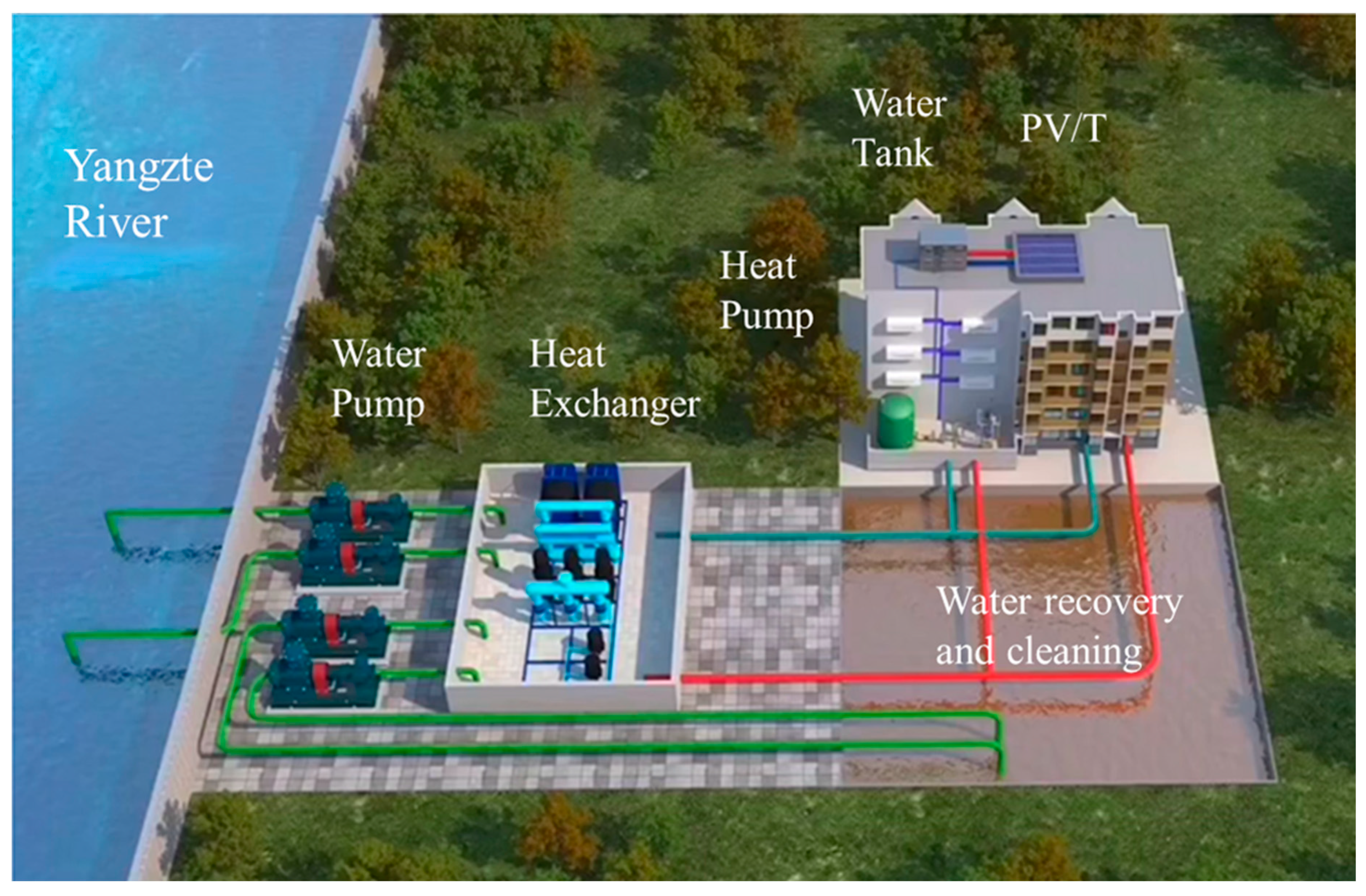
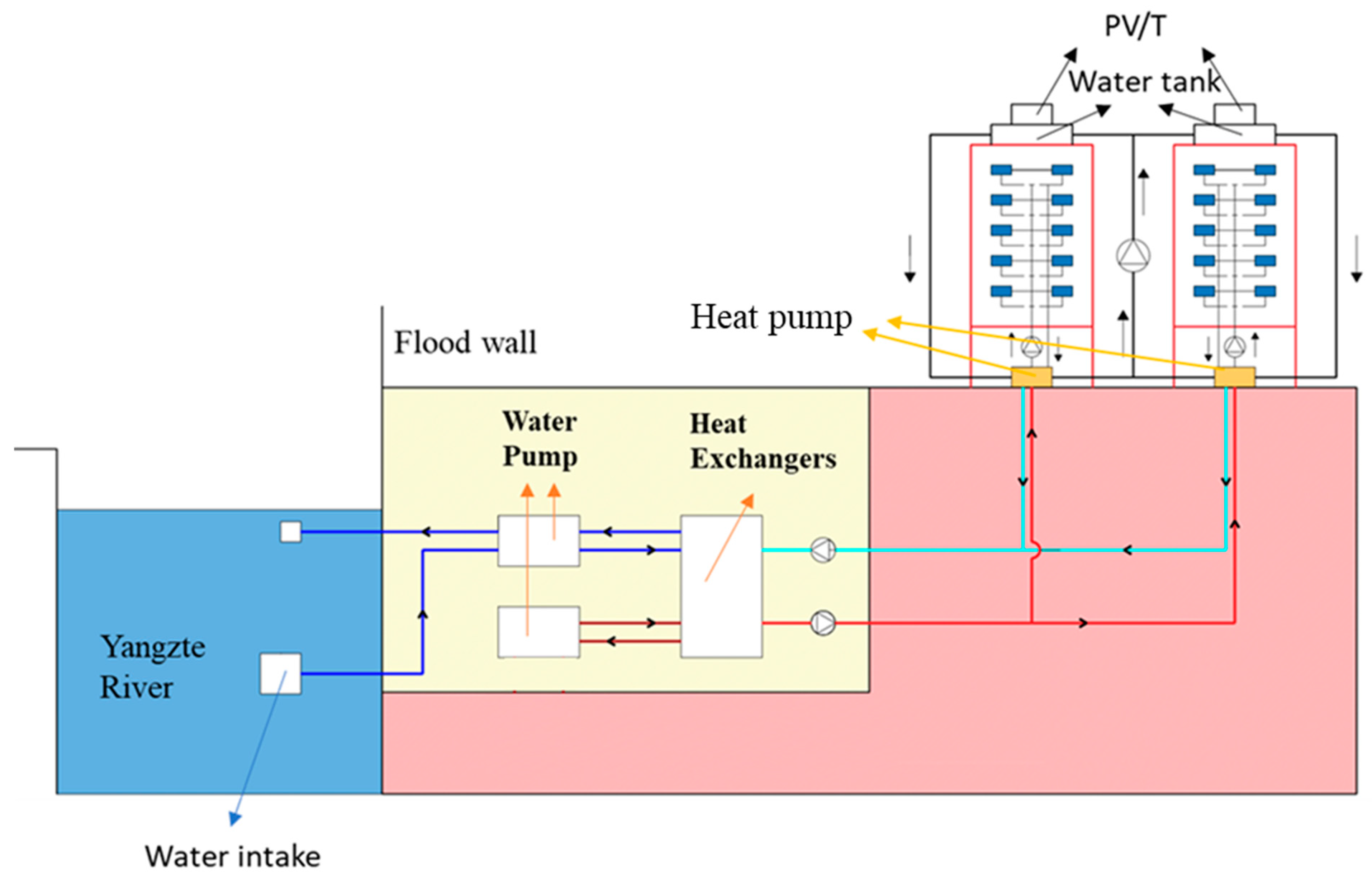
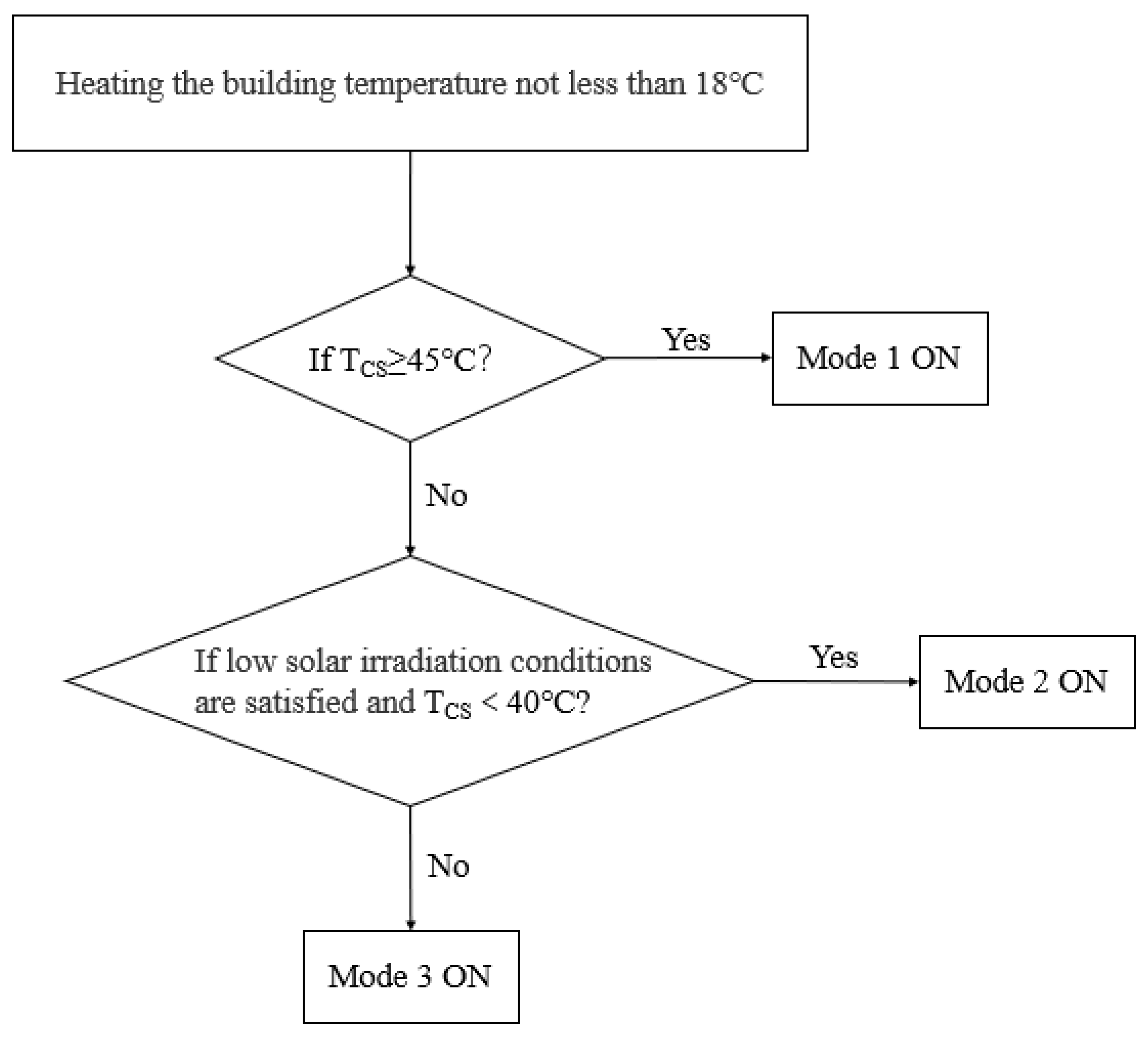
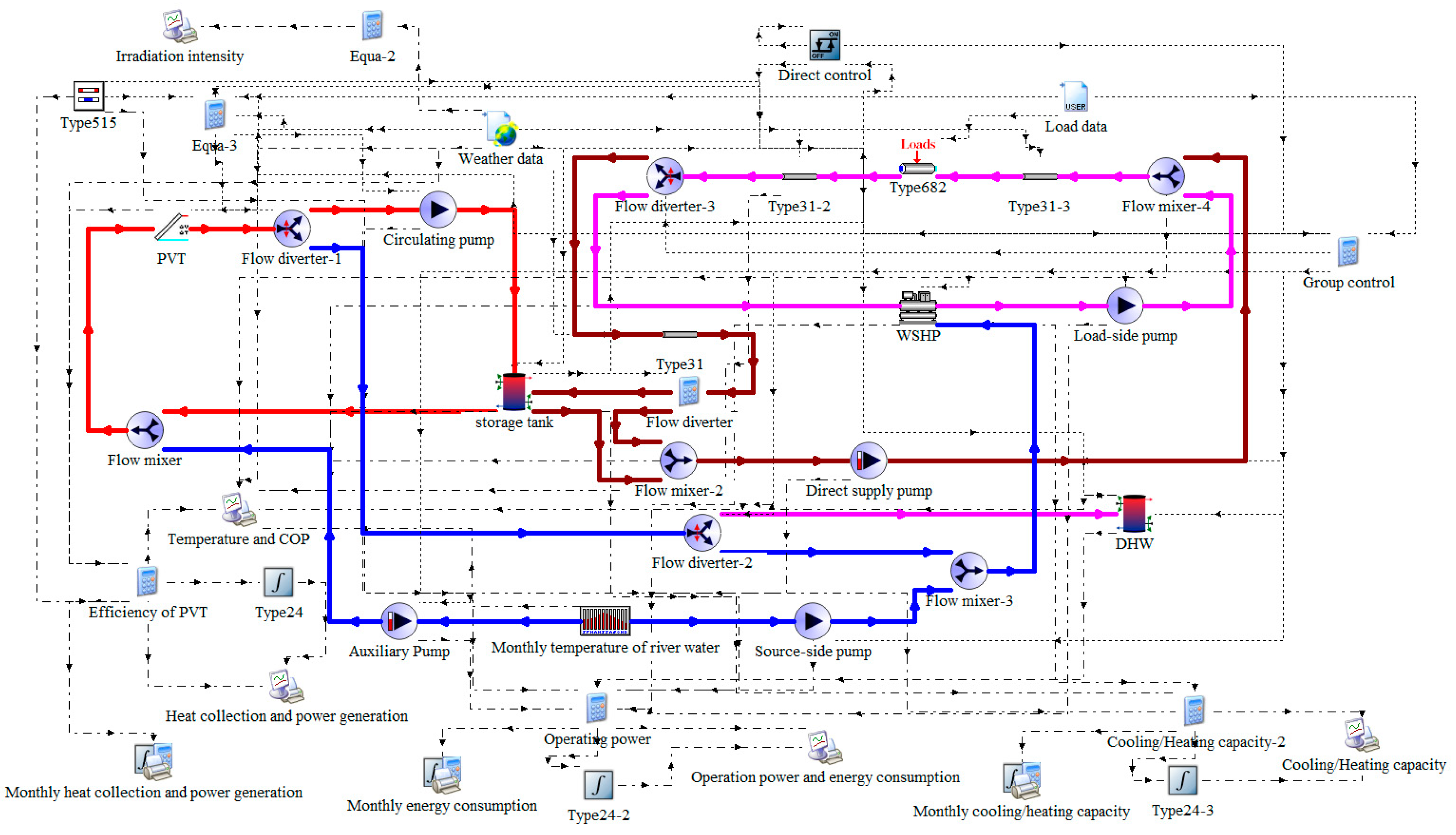
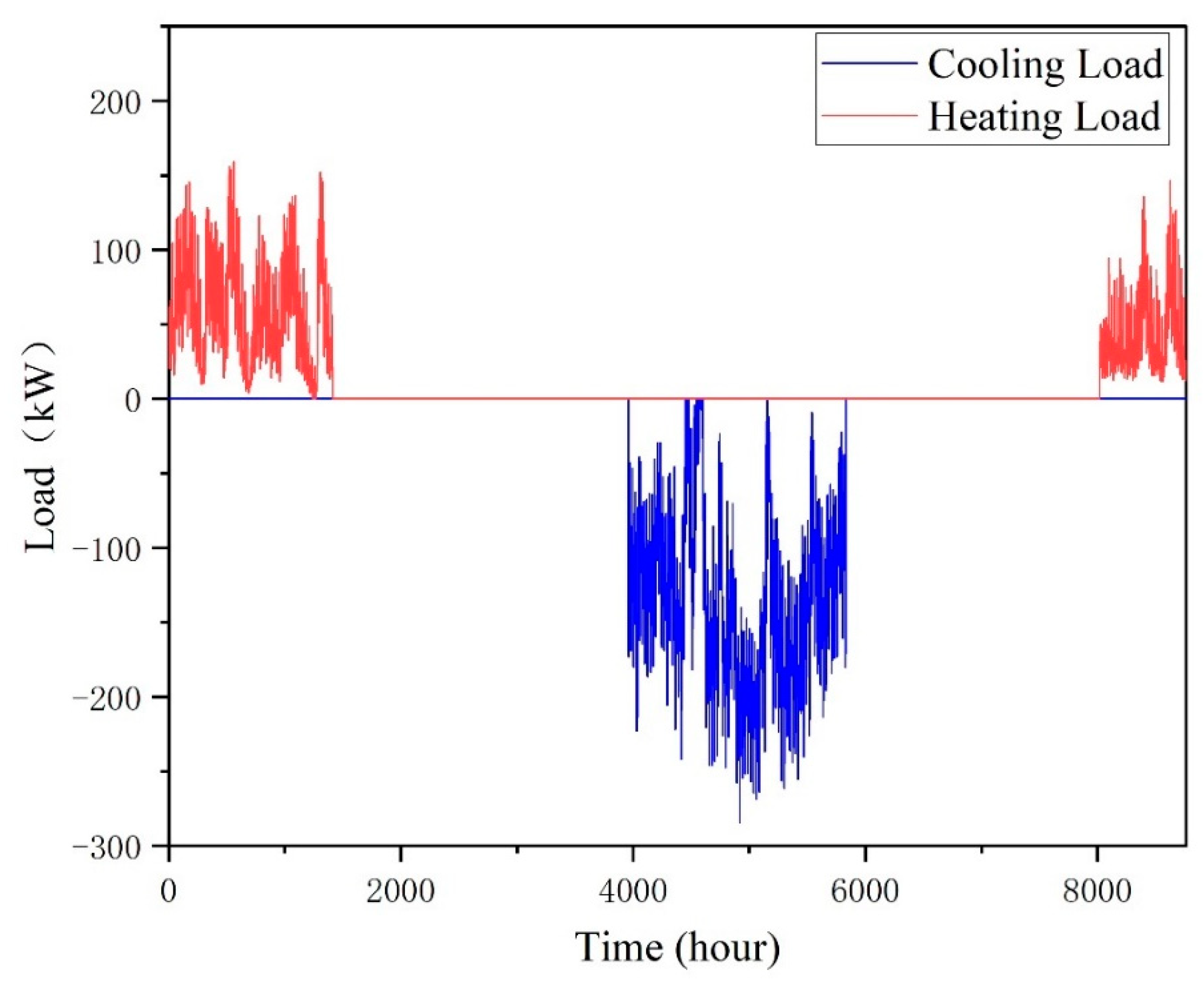
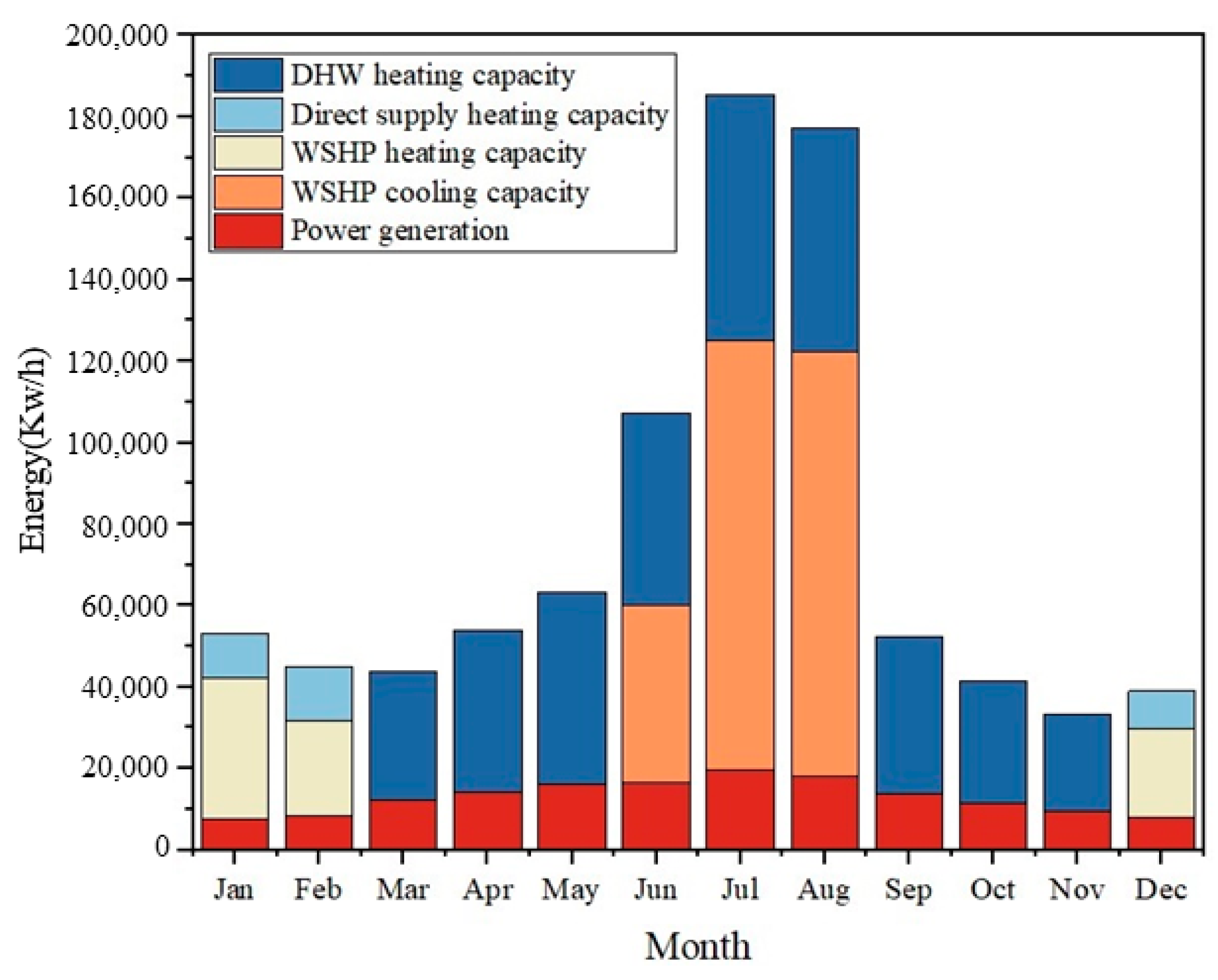
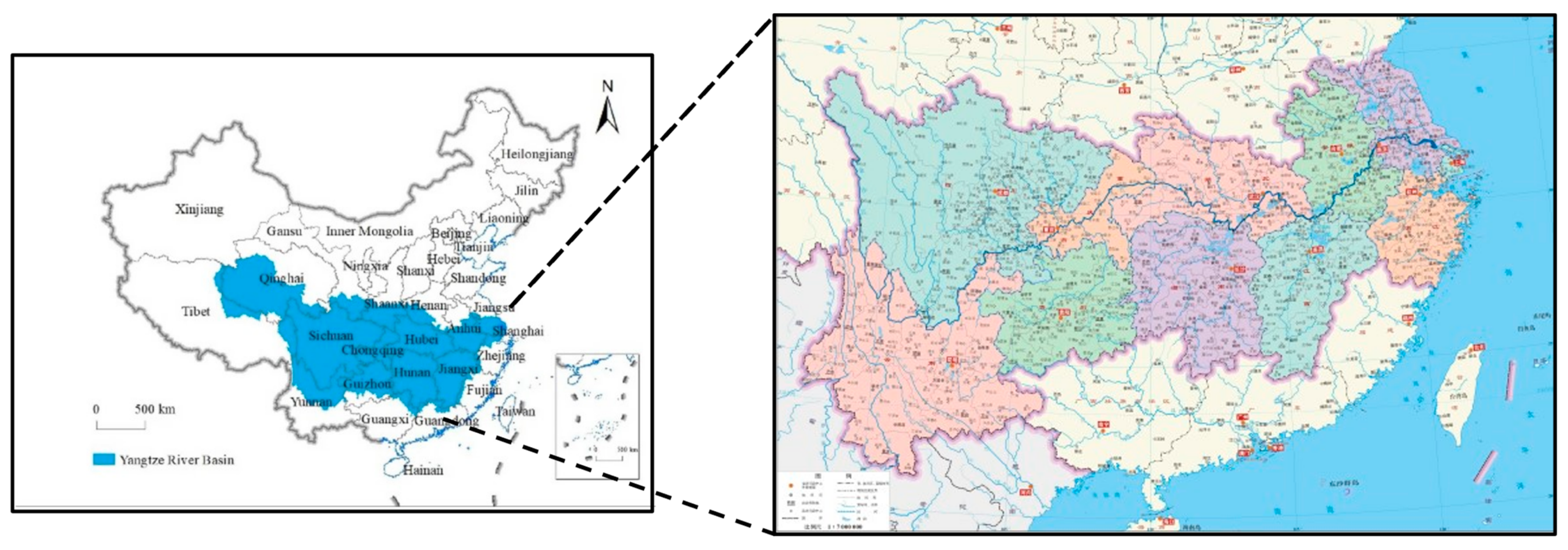
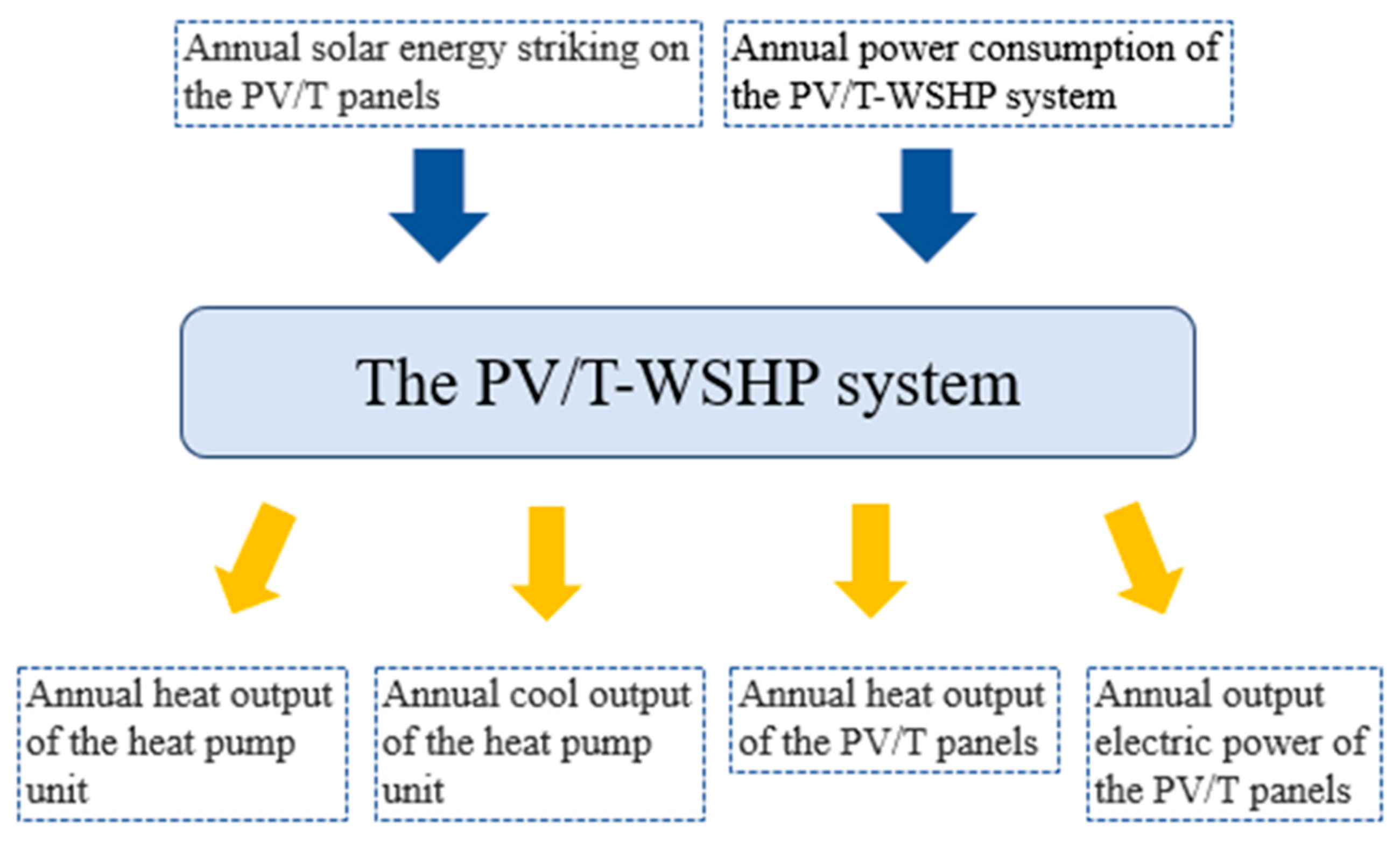
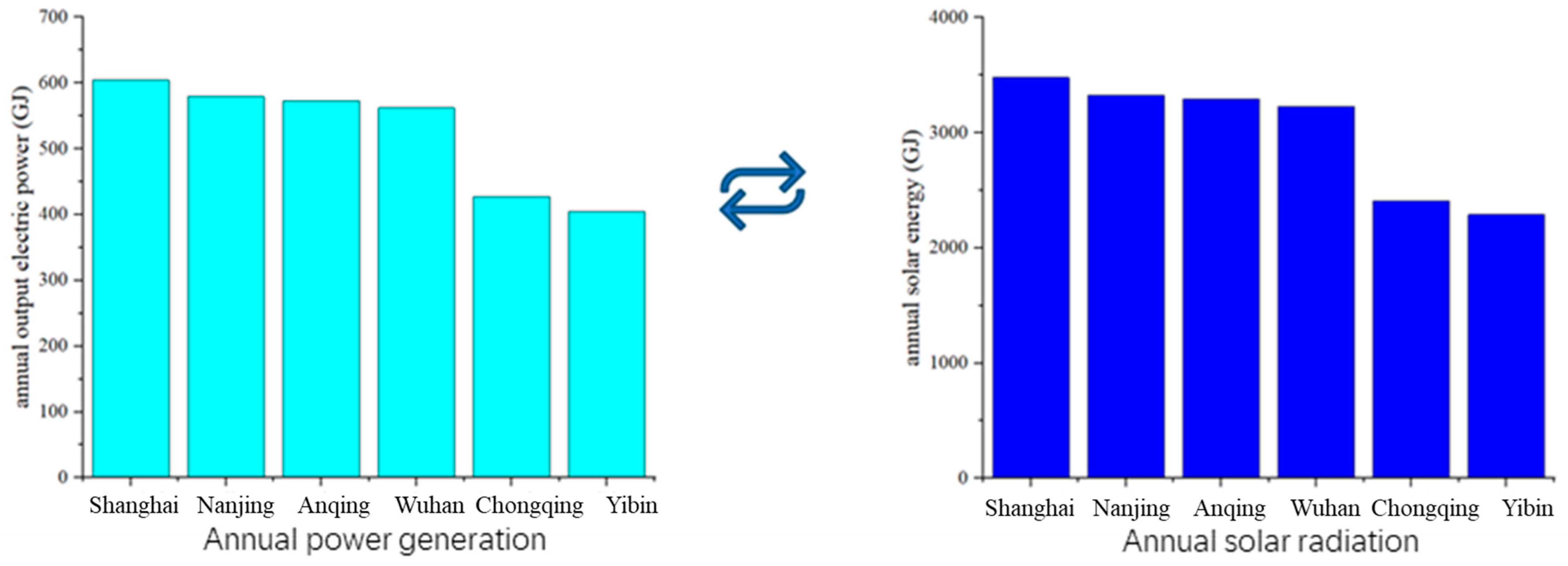
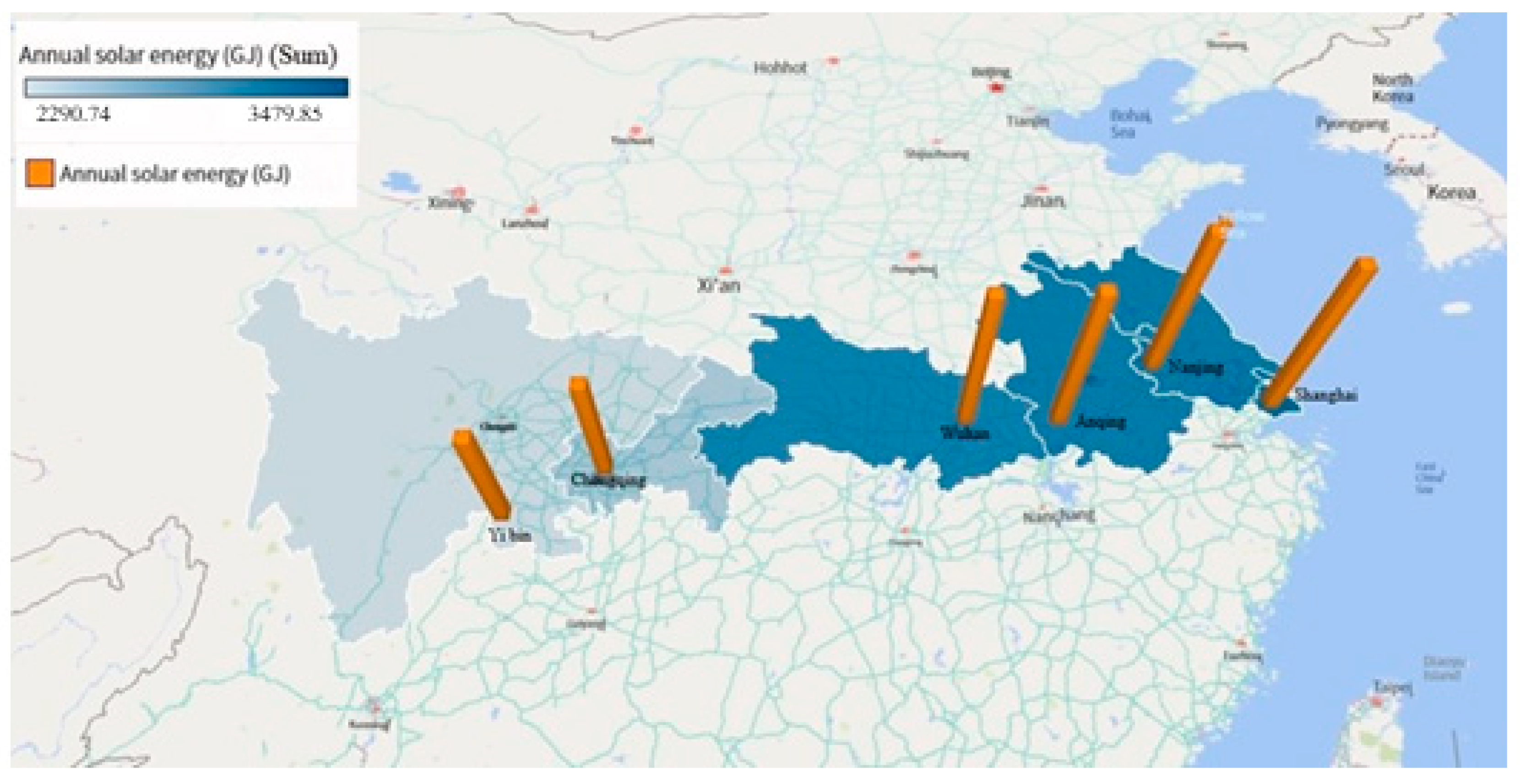
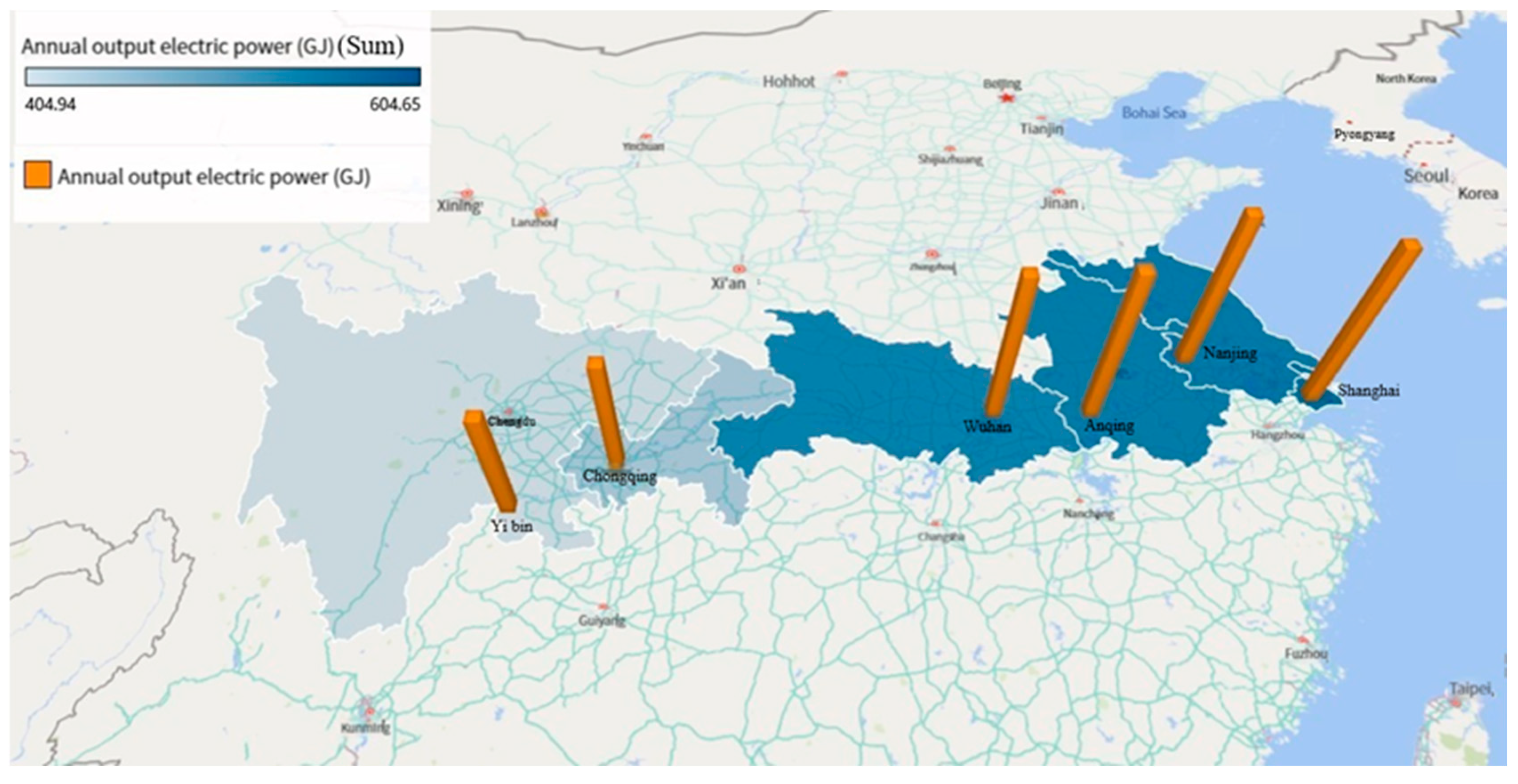

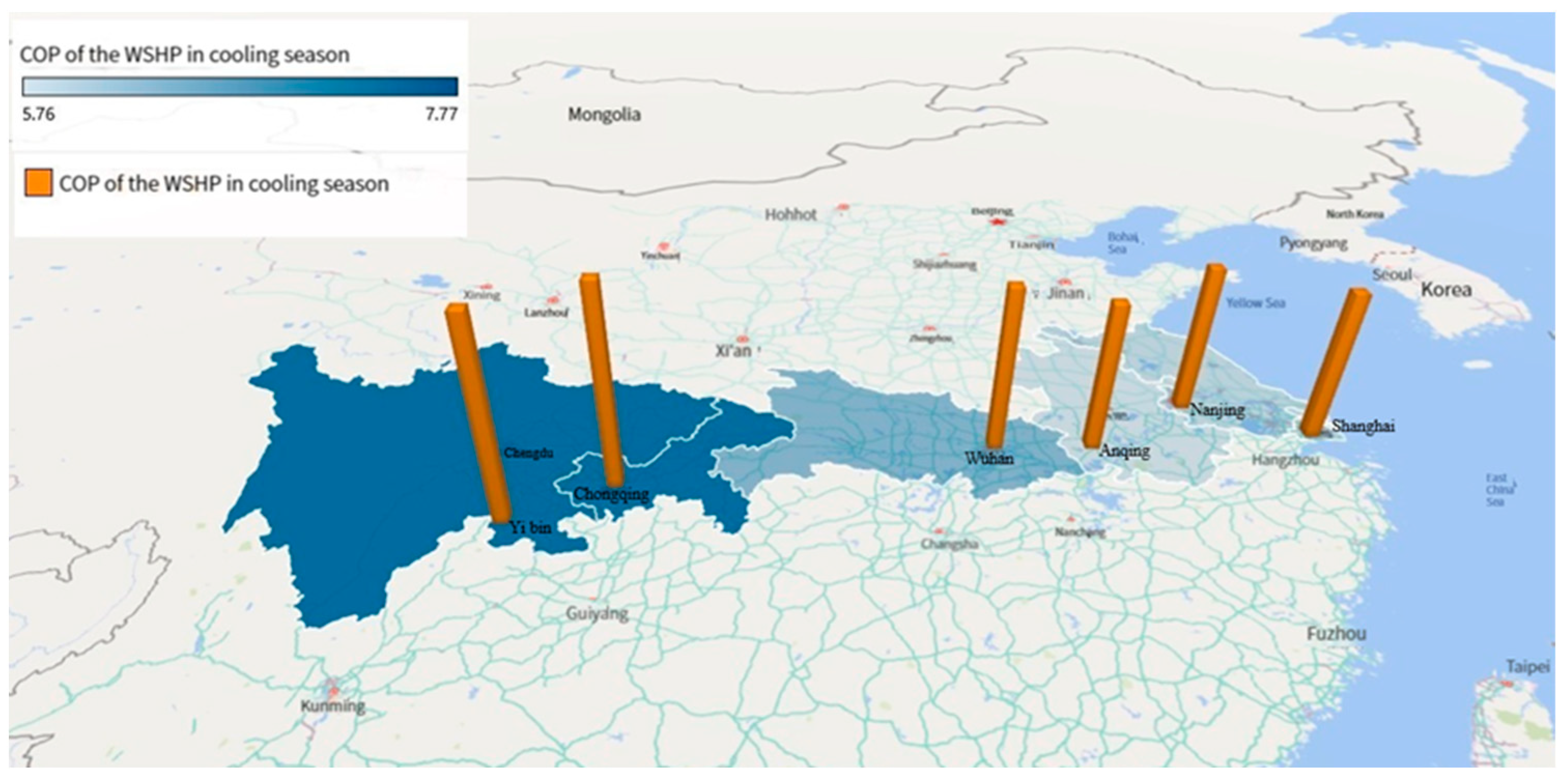
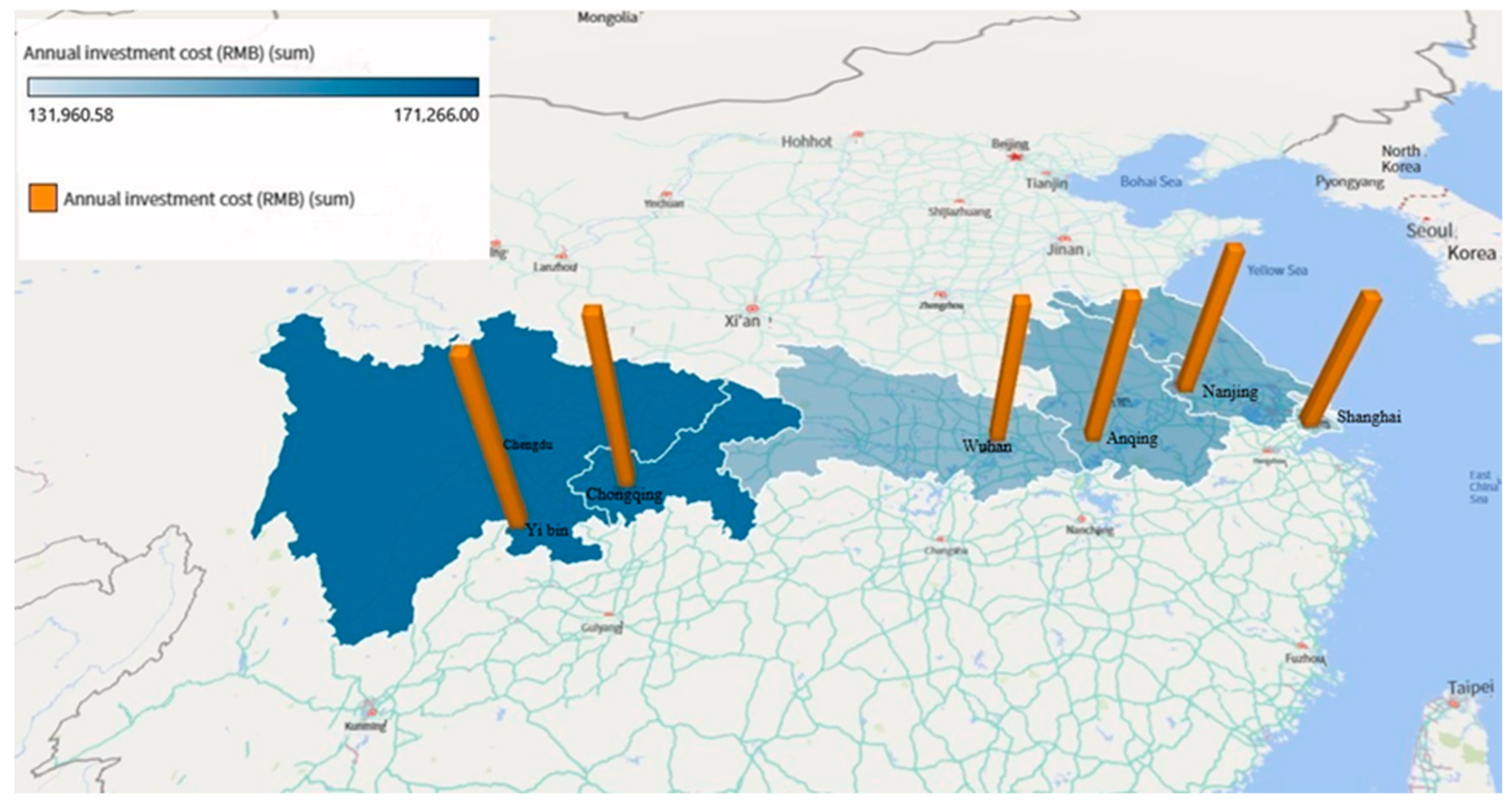

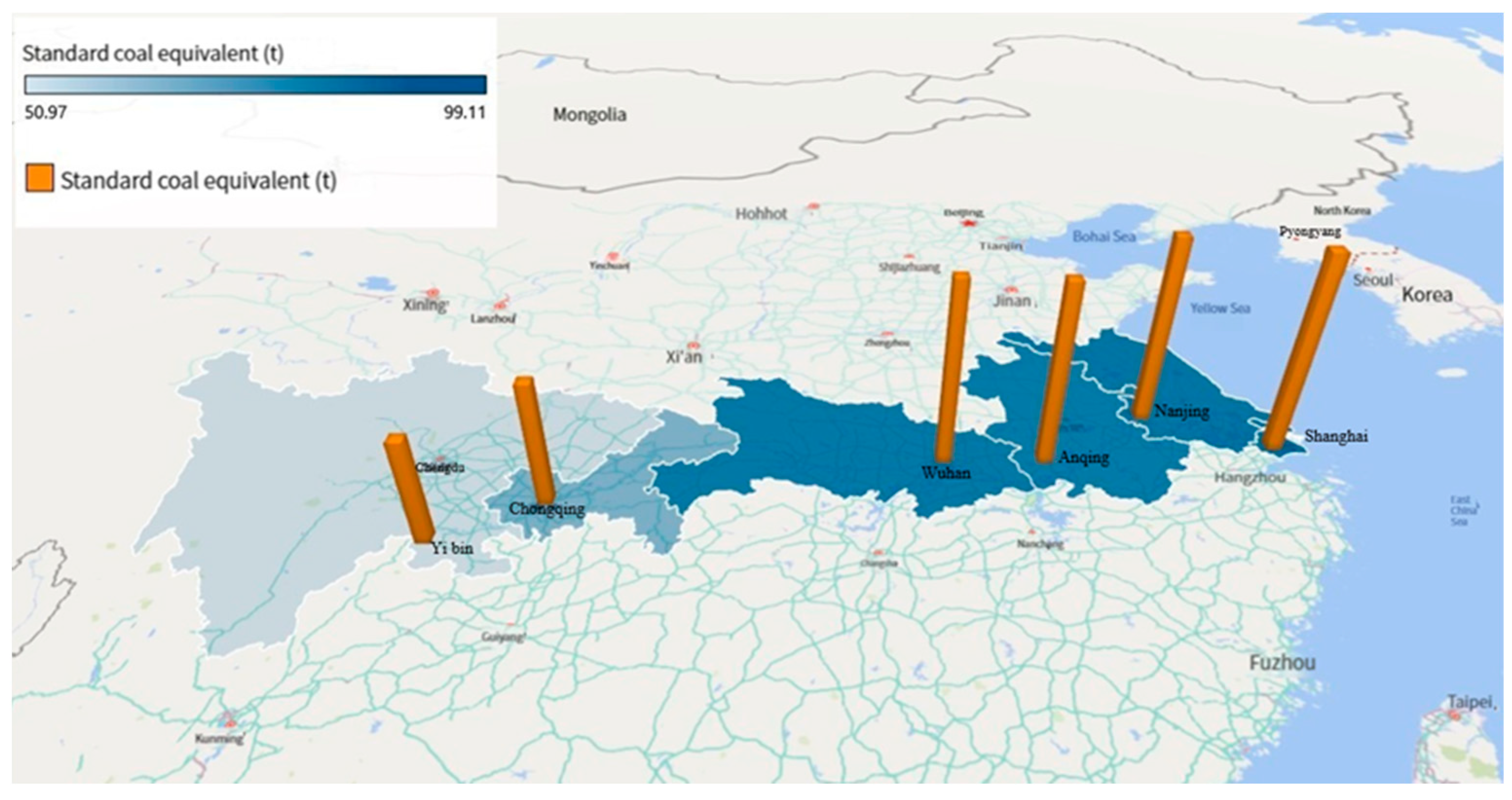
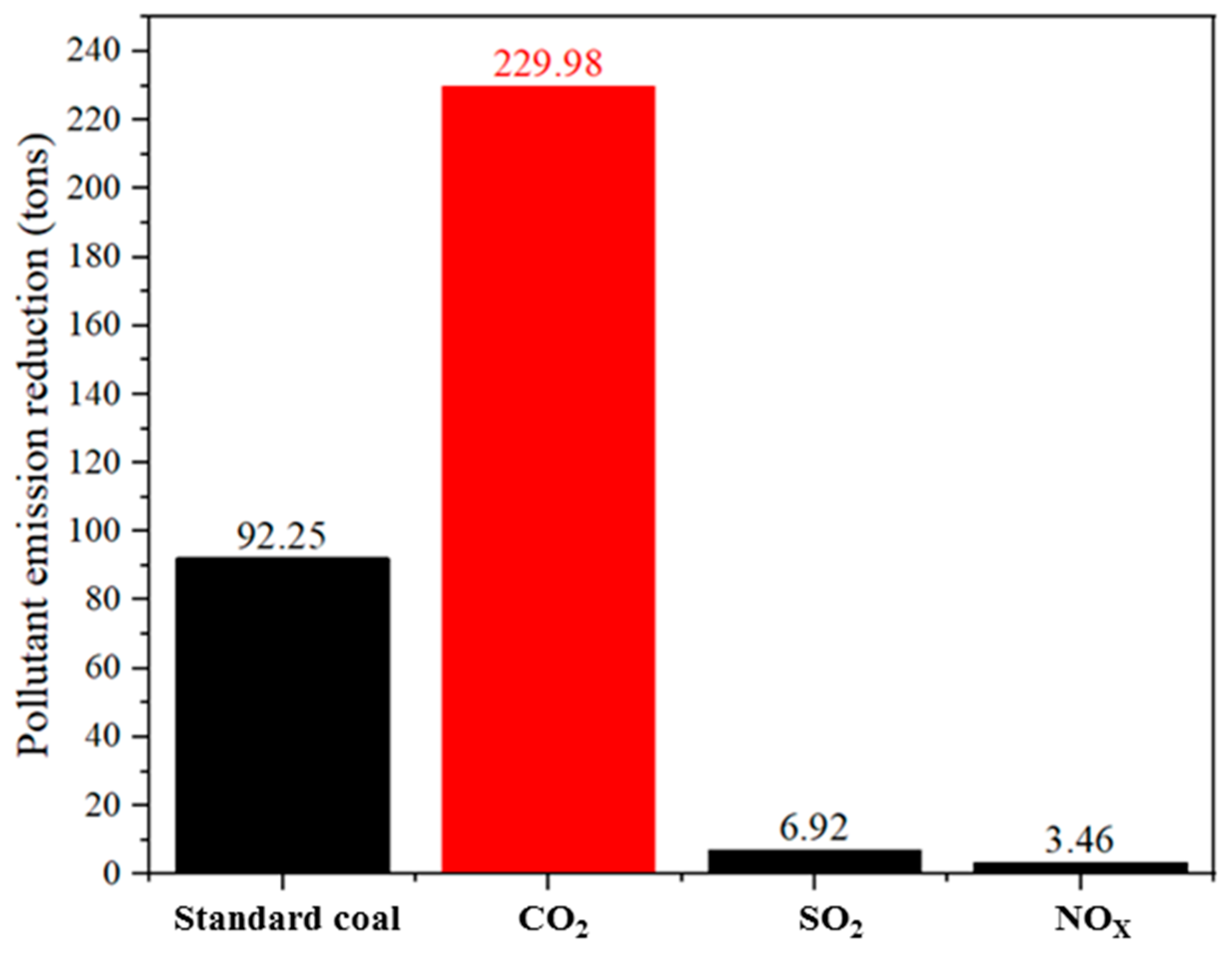
| Items | Emission Conversion Factor of Standard Coal, C |
|---|---|
| Electricity | 0.404 kg/kWh |
| Heat | 0.03412 kg/MJ |
| CO2 | 2.493 kg/kg |
| SO2 | 0.075 kg/kg |
| NOX | 0.0375 kg/kg |
| PM2.5 | 5.77 g/kg |
| Energy Balance (GJ) | ||||||
|---|---|---|---|---|---|---|
| Annual Solar Energy | Annual Power Consumption | Annual Cool Output of the HP Unit | Annual Heat Output of the HP Unit | Annual Heat Output of the PV/T Panels | Annual Output Electric Power | |
| Shanghai | 3479.85 | 419.92 | 911.29 | 254.8 | 1521.93 | 604.65 |
| Nanjing | 3326.4 | 438.96 | 911.3 | 294.03 | 1483.73 | 579.39 |
| Anqing | 3296.49 | 444.33 | 911.44 | 302.24 | 1421 | 573.21 |
| Wuhan | 3229.08 | 414.59 | 911.54 | 286.1 | 1461.53 | 562.17 |
| Chongqing | 2410.32 | 432.93 | 911.46 | 364.18 | 1055.48 | 427.78 |
| Yibin | 2290.74 | 431.36 | 911.43 | 367.05 | 827.96 | 404.94 |
| COP of the WSHP in Heating Season | COP of the WSHP in Cooling Season | |
|---|---|---|
| Shanghai | 3.35 | 5.76 |
| Nanjing | 3.34 | 5.76 |
| Anqing | 3.30 | 5.76 |
| Wuhan | 3.42 | 6.37 |
| Chongqing | 3.13 | 7.77 |
| Yibin | 3.14 | 7.77 |
| Jan | Feb | Mar | Apr | May | Jun | Jul | Aug | Sept | Oct | Nov | Dec | |
|---|---|---|---|---|---|---|---|---|---|---|---|---|
| Upward | 2.1 | 3.7 | 7.2 | 9 | 12 | 14.1 | 16 | 16.2 | 15.4 | 11.8 | 6.1 | 3.3 |
| Middle | 14.7 | 13.7 | 13.45 | 16.2 | 19.07 | 23.04 | 22.89 | 24.89 | 23.55 | 20.3 | 18.55 | 15.5 |
| Backward | 11.2 | 10.3 | 13.8 | 17.2 | 22.6 | 26.4 | 26.4 | 30 | 27.6 | 21.6 | 18.7 | 12.4 |
| Parameter | Value | Unit |
|---|---|---|
| Investment cost of water source heat pump | 500 | Yuan/Kw |
| Investment cost of source side pump | 3000 | Yuan |
| Investment cost of load side pump | 2000 | Yuan |
| Investment cost of circulating pump | 2000 | Yuan |
| Investment cost of auxiliary pump | 3000 | Yuan |
| Investment cost of direct supply pump | 3000 | Yuan |
| Investment cost of PV/T | 800 | Yuan/m2 |
| Investment cost of water storage tank | 1000 | Yuan/m3 |
| Control equipment investment cost | 35,000 | Yuan |
| Investment cost of pipeline, valve, auxiliary materials and installation | 30 | % |
| Inflation rate, i | 4.5 | % |
| Discount rate, d | 7 | % |
| Equipment life, n | 20 | Year |
| Maintenance cost ratio | 2 | % |
| Generation revenue ratio | Average tariff | KWh |
| Electricity price | Average tariff | KWh |
| Initial Investment (Yuan) | Annual Maintenance Cost (Yuan) | Annual Electricity Charge (Yuan) | Annual Generation Income (Yuan) | |
|---|---|---|---|---|
| Shanghai | 1,294,800 | 25,896 | 106,962.95 | 122,609.58 |
| Nanjing | 1,294,800 | 25,896 | 100,997.38 | 103,807.38 |
| Anqing | 1,294,800 | 25,896 | 109,601.4 | 112,200.6 |
| Wuhan | 1,294,800 | 25,896 | 100,539.04 | 107,749.71 |
| Chongqing | 1,294,800 | 25,896 | 98,611.83 | 75,693.3 |
| Yibin | 1,294,800 | 25,896 | 98,542.44 | 74,883.65 |
| First Level (Yuan/Kwh) | Second Level (Yuan/Kwh) | Third Level (Yuan/Kwh) | Average (Yuan/Kwh) | |
|---|---|---|---|---|
| Wuhan | 0.573 | 0.623 | 0.873 | 0.689 |
| Nanjing | 0.528 | 0.578 | 0.828 | 0.645 |
| Shanghai | 0.617 | 0.667 | 0.917 | 0.734 |
| Chongqing | 0.520 | 0.570 | 0.820 | 0.637 |
| Yibin | 0.552 | 0.622 | 0.822 | 0.666 |
| Anqing | 0.588 | 0.638 | 0.888 | 0.705 |
| Emission Conversion Coefficient of Standard Coal, C | |
|---|---|
| Electricity | 0.404 kg/kWh |
| Heat | 0.03412 kg/MJ |
| CO2 | 2.493 kg/kg |
| SO2 | 0.075 kg/kg |
| NOX | 0.0375 kg/kg |
| PM2.5 | 5.77 g/kg |
Disclaimer/Publisher’s Note: The statements, opinions and data contained in all publications are solely those of the individual author(s) and contributor(s) and not of MDPI and/or the editor(s). MDPI and/or the editor(s) disclaim responsibility for any injury to people or property resulting from any ideas, methods, instructions or products referred to in the content. |
© 2023 by the author. Licensee MDPI, Basel, Switzerland. This article is an open access article distributed under the terms and conditions of the Creative Commons Attribution (CC BY) license (https://creativecommons.org/licenses/by/4.0/).
Share and Cite
Wu, Q. Theoretical Evaluation of Photovoltaic Thermal Water Source Heat Pump, Application Potential and Policy Implications: Evidence from Yangtze River Economic Belt, China. Sustainability 2023, 15, 13638. https://doi.org/10.3390/su151813638
Wu Q. Theoretical Evaluation of Photovoltaic Thermal Water Source Heat Pump, Application Potential and Policy Implications: Evidence from Yangtze River Economic Belt, China. Sustainability. 2023; 15(18):13638. https://doi.org/10.3390/su151813638
Chicago/Turabian StyleWu, Qiuyi. 2023. "Theoretical Evaluation of Photovoltaic Thermal Water Source Heat Pump, Application Potential and Policy Implications: Evidence from Yangtze River Economic Belt, China" Sustainability 15, no. 18: 13638. https://doi.org/10.3390/su151813638
APA StyleWu, Q. (2023). Theoretical Evaluation of Photovoltaic Thermal Water Source Heat Pump, Application Potential and Policy Implications: Evidence from Yangtze River Economic Belt, China. Sustainability, 15(18), 13638. https://doi.org/10.3390/su151813638





